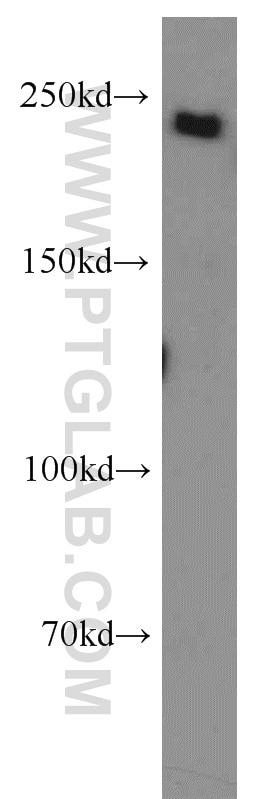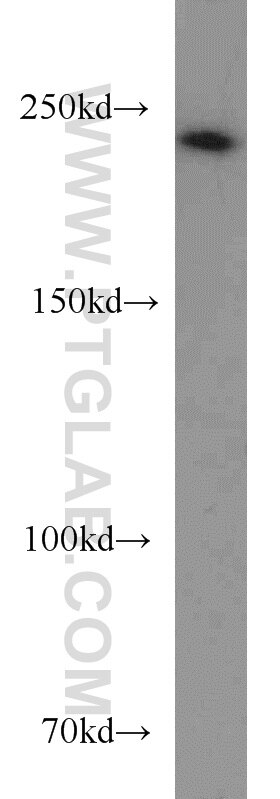Tested Applications
| Positive WB detected in | HeLa cells, HEK-293 cells, Jurkat cells |
| Positive IP detected in | HEK-293 cells |
| Positive IHC detected in | human stomach cancer tissue Note: suggested antigen retrieval with TE buffer pH 9.0; (*) Alternatively, antigen retrieval may be performed with citrate buffer pH 6.0 |
Recommended dilution
| Application | Dilution |
|---|---|
| Western Blot (WB) | WB : 1:500-1:2000 |
| Immunoprecipitation (IP) | IP : 0.5-4.0 ug for 1.0-3.0 mg of total protein lysate |
| Immunohistochemistry (IHC) | IHC : 1:500-1:2000 |
| It is recommended that this reagent should be titrated in each testing system to obtain optimal results. | |
| Sample-dependent, Check data in validation data gallery. | |
Published Applications
| WB | See 2 publications below |
| IP | See 1 publications below |
Product Information
23073-1-AP targets SUPT6H in WB, IHC, IP, ELISA applications and shows reactivity with human samples.
| Tested Reactivity | human |
| Cited Reactivity | human |
| Host / Isotype | Rabbit / IgG |
| Class | Polyclonal |
| Type | Antibody |
| Immunogen |
CatNo: Ag19426 Product name: Recombinant human SUPT6H protein Source: e coli.-derived, PGEX-4T Tag: GST Domain: 1618-1726 aa of BC136524 Sequence: TPSYSYTTPSQPITTPQYHQLQASTTPQSAQAQPQPSSSSRQRQQQPKSNSHAAIDWGKMAEQWLQEKEAERRKQKQRLTPRPSPSPMIESTPMSIAGDATPLLDEMDR Predict reactive species |
| Full Name | suppressor of Ty 6 homolog (S. cerevisiae) |
| Calculated Molecular Weight | 1726 aa, 199 kDa |
| Observed Molecular Weight | 230 kDa |
| GenBank Accession Number | BC136524 |
| Gene Symbol | SUPT6H |
| Gene ID (NCBI) | 6830 |
| RRID | AB_11232593 |
| Conjugate | Unconjugated |
| Form | Liquid |
| Purification Method | Antigen affinity purification |
| UNIPROT ID | Q7KZ85 |
| Storage Buffer | PBS with 0.02% sodium azide and 50% glycerol, pH 7.3. |
| Storage Conditions | Store at -20°C. Stable for one year after shipment. Aliquoting is unnecessary for -20oC storage. 20ul sizes contain 0.1% BSA. |
Background Information
SUPT6H (suppressor of Ty6 homolog), also known as SPT6, SPT6H, Tat-CT2 (Tat-cotransactivator 2 protein) or emb-5 in C. elegans, is a 1,726 amino acid protein that is highly conserved from yeast to humans. Expressed ubiquitously, SUPT6H localizes to the nucleus and contains one SH2 domain and one S1 domain. SUPT6H participates in both DRB (5,6-dichloro-1-beta-D-ribofuranosylbenzimidazole)-mediated transcriptional inhibition as well as the enhancement of transcriptional elongation by the RNA polymerase II (Pol II). SUPT6H interacts with the nuclear proteins SPT4 and SPT5, which comprise the DSIF (DRB-sensitivity-inducing factor) complex that binds RNA polymerase II, and directly regulates elongation. Via its C-terminus, SUPT6H can also interact with Histone H3. Due to alternative splicing events, three isoforms exist for SUPT6H. This antibody specifically recognizes the 230kd phosphorylated SUPT6H protein.
Protocols
| Product Specific Protocols | |
|---|---|
| IHC protocol for SUPT6H antibody 23073-1-AP | Download protocol |
| IP protocol for SUPT6H antibody 23073-1-AP | Download protocol |
| WB protocol for SUPT6H antibody 23073-1-AP | Download protocol |
| Standard Protocols | |
|---|---|
| Click here to view our Standard Protocols |
Publications
| Species | Application | Title |
|---|---|---|
Nat Commun TASOR epigenetic repressor cooperates with a CNOT1 RNA degradation pathway to repress HIV. | ||
Reviews
The reviews below have been submitted by verified Proteintech customers who received an incentive for providing their feedback.
FH Lucas (Verified Customer) (04-15-2025) | Works really well in IP and Western Blot
|
FH Roy (Verified Customer) (06-12-2024) | The antibody detects SUPT6H from HeLa and Jurkat cells by WB (1/1000 dilution - Overnight incubation at 4°C).
|
FH Fabienne (Verified Customer) (06-07-2024) | Works very well in IP and Western blot
|
FH Mrinmoyee (Verified Customer) (09-21-2018) |
 |












